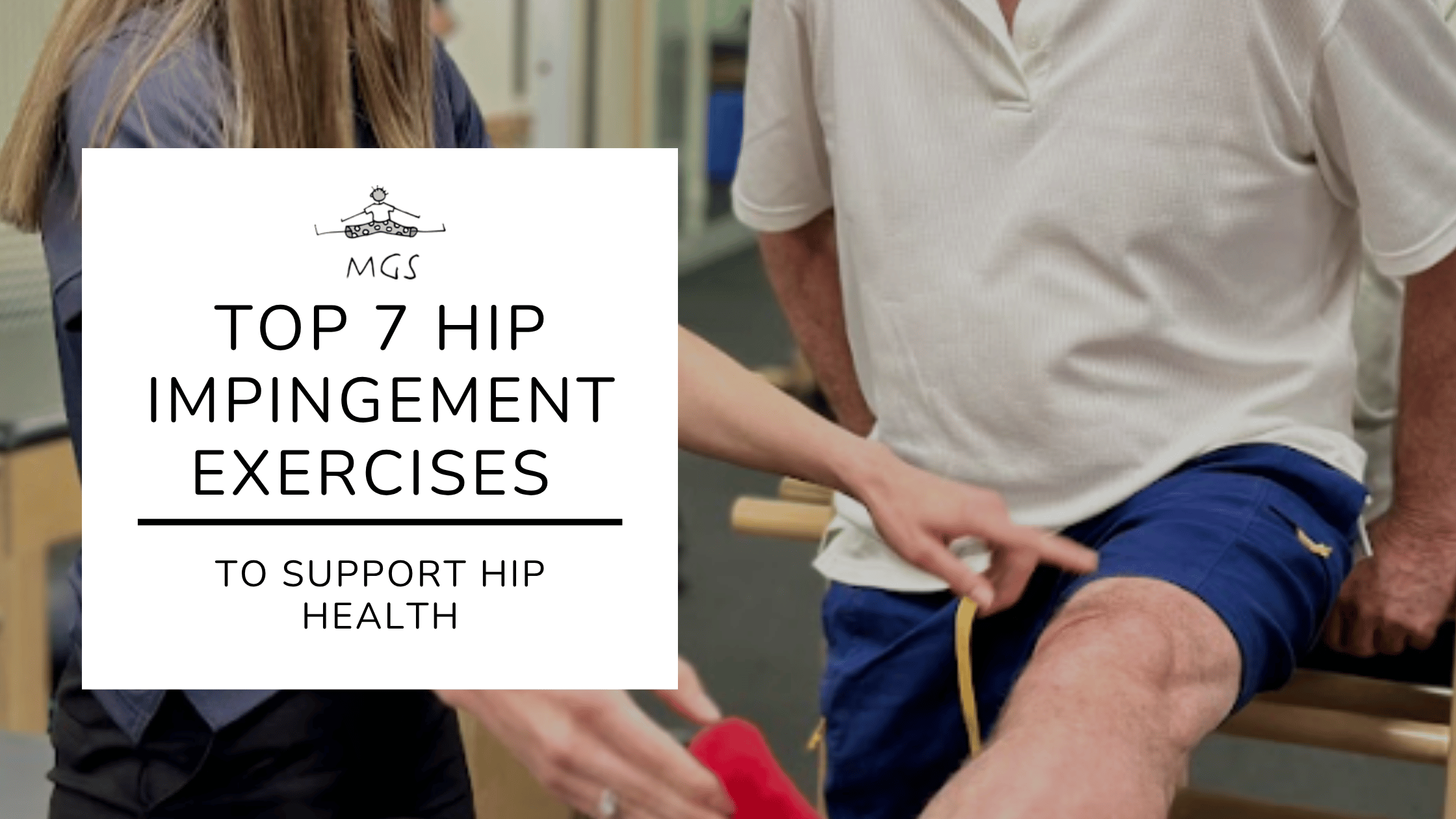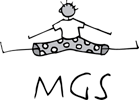Key Takeaways
- Hip impingement (femoroacetabular impingement) causes groin pain, stiffness, and reduced mobility, particularly in active individuals.
- Physiotherapy-led hip impingement exercises help relieve symptoms, strengthen supporting muscles, and improve joint function.
- Key exercises include the hip flexor stretch, 90/90 mobility drill, glute bridges, clamshells, standing hip abductions, deep squat holds, and reverse lunges.
- Strengthening the glutes and improving hip rotation are crucial for reducing joint strain and preventing further injury.
- Sports physiotherapy provides tailored treatment plans, manual therapy, and personalised rehabilitation to accelerate recovery.
- MGS Physiotherapy offers one-on-one care across Manly, North Curl Curl, and Mona Vale to support clients through recovery and prevent recurrence.
- Early physiotherapy intervention leads to faster healing, improved mobility, and better long-term outcomes.

If you’re experiencing hip pain, stiffness, or discomfort during activity, you may be dealing with hip impingement, also known as femoroacetabular impingement (FAI). This common condition affects many active individuals, not just elite athletes. Hip impingement can be caused by cam impingement, where the femoral head is abnormally shaped, or pincer impingement, which involves overcoverage of the femoral head by the acetabulum. The good news? Specific hip impingement exercises can help relieve pain, restore function, and support long-term hip health.
At MGS Physiotherapy, we believe in early physiotherapy intervention to promote faster healing, reduce downtime, and prevent re-injury. The hip joint is formed by the acetabulum of the pelvis and the spherical head of the thigh bone (femur), and impingement occurs when abnormal contact between these structures leads to pain and limited movement. In this guide, we share the top seven hip impingement exercises used by physiotherapists to improve strength, mobility, and joint support.
Symptoms of hip impingement can worsen over time, and untreated cases may result in reduced mobility, chronic pain, and early osteoarthritis.
Physiotherapy treatment is often the first-line approach for the affected hip, focusing on pain reduction, flexibility, and strengthening. Treating femoroacetabular impingement may involve nonoperative and postoperative management strategies, with surgical intervention considered if conservative measures do not provide relief.
What Is Hip Impingement?
Hip impingement happens when the ball and socket of the hip joint come into abnormal contact, often causing pain in the groin or front of the hip. It’s commonly triggered by repetitive motion or underlying structural issues. Femoroacetabular impingement (FAI) occurs when the bones of the hip joint are not shaped normally, which causes abnormal contact between the femur and acetabulum during hip motion. Without proper treatment, it may lead to reduced range of motion or even labral damage. The hip joints play a crucial role in movement and stability, and issues like impingement or osteoarthritis can significantly affect their function.
Incorporating targeted hip impingement exercises into your daily routine can improve joint mechanics, reduce stress on the hip, and accelerate recovery, especially when combined with tailored treatment from a qualified physiotherapist. While many exercises can help improve hip strength and mobility, targeted exercises and recommended exercises are most effective for managing hip impingement and supporting the function of the hip joints. Hip strengthening exercises, including clamshells and hip bridges, are recommended to enhance hip stability.
Identifying Common Symptoms of Hip Impingement
Recognising the early signs of hip impingement is crucial for protecting your hip health and preventing long-term joint damage. Femoroacetabular impingement syndrome (FAI) often develops gradually, and its symptoms can be mistaken for general muscle soreness or overuse. However, paying attention to specific warning signs can help you take action before the condition worsens.
The most common symptom of hip impingement is persistent hip pain, especially during movements that involve significant hip flexion, such as bending, squatting, or twisting. Many people notice discomfort in the front of the hip or deep in the groin, but pain can also radiate to the thigh, buttocks, or even the knee. Stiffness in the hip joint and a reduced range of motion are also frequent complaints, making it difficult to perform daily activities or participate in sports.
You might experience increased pain after prolonged sitting or repetitive movements that require internal or external rotation of the hip. Some individuals report a sensation of catching, clicking, or locking in the hip, which can signal abnormal contact between the femoral head and the socket. In the early stages, these symptoms may come and go, but over time, they can become more persistent and interfere with your quality of life.
If you notice any of these common symptoms, it’s important to consult a physical therapist or healthcare professional. Early intervention with physical therapy exercises, manual therapy, and core strengthening exercises can help relieve pain, improve hip mobility, and strengthen the surrounding hip muscles. Avoiding activities that aggravate hip impingement—such as deep squats, high-impact sports, or repetitive hip flexion—can also prevent further irritation.
A tailored treatment plan that includes strengthening exercises, hip flexor stretches, and modifications to your daily routine can make a significant difference in managing symptoms and supporting long-term hip health. By addressing hip impingement early, you can reduce pain, restore function, and get back to the activities you love with confidence.
1. Supine Hip Flexor Stretch
This gentle stretch targets tight hip flexors, which can worsen impingement symptoms. It is important to begin in the correct starting position to ensure the stretch is both safe and effective.
How to perform:
- Lie on your back with both legs extended (this is your starting position).
- Pull one knee towards your chest.
- Keep the opposite leg flat on the floor.
- Hold for 30 seconds. Return to the starting position. Repeat on both sides, 2–3 times.
You may experience mild discomfort during the stretch, which is normal, but stop if you feel pain.
This stretch reduces anterior hip tightness, a key contributor to hip impingement, and specifically targets the iliopsoas muscle group.
2. 90/90 Hip Mobility Stretch
Improving hip rotation is vital for reducing impingement-related discomfort.
How to perform:
- Sit with one leg bent in front and the other behind, both at 90 degrees.
- Keep your torso upright and lean forward gently.
- Hold for 20–30 seconds, then switch sides.
- Perform 2 sets on each side.
This movement targets internal and external hip rotation, often limited in those with FAI. This stretch helps improve hip flexibility and can also target the piriformis muscle, which plays a key role in hip stabilisation and mobility.
3. Glute Bridge
One of the most important hip impingement exercises for strengthening the glutes and relieving hip joint pressure.
How to perform:
- Lie on your back with knees bent and feet flat.
- Engage your glutes and lift your hips upward.
- Hold for 2 seconds, then slowly lower.
- Complete 2–3 sets of 10–15 reps.
The glute bridge is effective for building hip strength and improving hip extension, both of which are essential for rehabilitation and restoring proper hip mechanics.
Glute strength plays a major role in pelvic stability and proper hip mechanics.
4. Clamshell Exercise
Clamshells target the gluteus medius, which supports hip alignment and reduces strain during walking and running.
How to perform:
- Lie on your side with your legs bent, knees bent and feet together.
- Keep your feet touching and lift your top knee.
- Lower slowly without moving your pelvis.
- Perform 2 sets of 15 reps per side.
This is a low-impact but powerful exercise for hip stabilisation.
5. Standing Hip Abduction
Builds strength in the lateral hip muscles, which helps reduce pinching at the front of the hip. Hip hikes are another effective exercise for strengthening the lateral hip muscles.
How to perform:
- Stand upright, holding onto a chair for balance.
- Slowly lift one leg out to the side.
- Return to the centre without swinging.
- Perform 2–3 sets of 10–12 reps per leg.
Use a resistance band around your ankles to increase difficulty if needed.
6. Supported Deep Squat Hold
A functional mobility drill to stretch the hips and improve joint range without aggravating symptoms.
How to perform:
- Stand with feet shoulder-width apart.
- Hold onto a pole or sturdy object for balance.
- Lower into a deep squat, keeping heels down.
- Hold for 20–30 seconds and repeat 2–3 times.
This squat hold also acts as a groin stretch and targets the inner thigh muscles, helping to relieve tightness in these areas.
Squat holds help improve hip mobility while reinforcing good movement patterns.
7. Reverse Lunges
Reverse lunges build strength and balance without the anterior hip loading that can aggravate impingement.
How to perform:
- Stand tall with feet hip-width apart.
- Step back with one foot and bend both knees.
- Push through the front heel to return to standing.
- Perform 2 sets of 8–10 reps per leg. Core strengthening is important for improving overall hip health.
Straight leg raises can also be included as a complementary exercise to further improve hip stability.
This is a great progression for building functional strength safely.
Why Hip Impingement Exercises Work Best with Physiotherapy
While these exercises can support recovery, not all hips are the same. If you’re unsure which movements are safe for your condition, it’s best to consult a physiotherapist. Therapeutic exercise approaches and core exercises are key components of both nonoperative and postoperative management for hip impingement, helping to improve pelvic control, stability, and overall hip function. Managing FAI with non-surgical treatments typically involves a tailored exercise program designed by a physical therapist. At MGS Physiotherapy, our team specialises in sports physiotherapy to create individualised exercise programs and hands-on treatment tailored to your needs.
Whether you’re managing pain, recovering from surgery and require postoperative management, or preparing to return to sport, our sports physio team can help improve mobility, reduce discomfort, and fast-track your recovery.
We provide one-on-one physiotherapy in Manly, North Curl Curl, and Mona Vale — designed for active people like you.
The MGS Approach to Sports Physio for Hip Impingement
Our approach goes beyond just exercise. At MGS Physiotherapy, you’ll receive:
- Tailored treatment plans based on your injury and goals
- Manual therapy to relieve joint pressure and restore movement
- Personalised exercise routines to build strength and prevent recurrence
- Ongoing care to track progress and adjust your rehab plan
We support not just recovery, but long-term injury prevention — helping you return to your favourite activities with confidence.
Learn more about our sports physiotherapy services and how we can support your hip impingement treatment today.
Final Thoughts
If you’re experiencing hip pain during sport or daily activity, don’t wait for it to worsen. These hip impingement exercises are a valuable starting point for reducing pain and restoring function, but a comprehensive treatment plan from a physiotherapist offers the best results. Exercises that involve significant hip flexion with internal or external rotation, such as high knees, should be avoided with hip impingement.
CALL NOW TO BOOK YOUR APPOINTMENT
